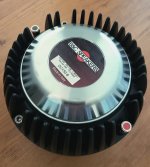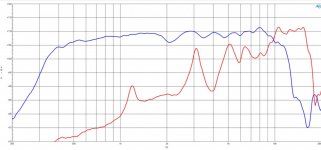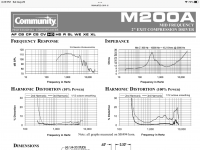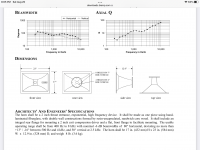Does anyone have hands on experience with the DCX50 driver and is there a proven WG and crossover design for use in a studio monitor type speaker setup?
This looks like a very nice driver but I can't find any existing designs that employ it.
This looks like a very nice driver but I can't find any existing designs that employ it.
Well, they arrived today and I'm eager to investigate these crazy looking drivers. They look like works of art and of course the Italians know their style. Now all they have to do is sound amazing in large 1 + 2 way speakers. This is the first time I've used a coax CD in one of my own designs. I have 2 different horns coming. Stay tuned...


Last edited by a moderator:
Another reason I chose this driver was the wide bandwidth of the mid portion, which runs from 400 and extends out past 8k. The HF portion is just basically a super tweeter, and that keeps the crossover out of the critical 1K to 6k area. The mid-only version DCM50 has the identical driver element as the DCX50. On a basic horn it sounds so smooth and effortless, yet detailed and fast. You know the distortion is low when trying to have a casual conversation with the guy next to you with music playing, you end up shouting to hear each other. Brass, woodwinds and drums sound so real in the room you could touch them with your eyes closed. The only other driver that soumded this way was the Celestion AXI2050. The other large BMS coax people often talk about is much harder to work with IMO. Not saying its a bad driver, just that it takes much more work to get it sounding right than the other two.
I know the factory curves need to be taken with a grain of salt, but the midrange does sound like it measures below, however measured on a different unknown horn.
I know the factory curves need to be taken with a grain of salt, but the midrange does sound like it measures below, however measured on a different unknown horn.
Attachments
I just did a quick sine wave sweep on both driver elements with the driver in free air. There are no audible resonances to speak of and respomse is very smooth (too smooth), even without a horn and using my high source impedance sweep generator. I find this impressive. No other driver I've ever tested this way has (audibly) performed this well - usually there are at least some fundamental impedance peaks, but not with this driver. Promising observations so far...
I wonder if anyone has experimented with a k-tube on a coax driver or even a 2 inch driver? Probably wouldn't reach down far enough into the low mids without significant THD. Hmmm...
I printed some K-Tubes for my JBL2445 driver - not sure if I ever tried them. The large 3" tube with a 3FE22 was quite nice though. Printing a 1.4" tube for my DCX464 might be worthwhile after I get the passive crossover parts together.
An interesting thread is here: https://www.diyaudio.com/community/threads/fieldcoil-k-tube.363723/
An interesting thread is here: https://www.diyaudio.com/community/threads/fieldcoil-k-tube.363723/
find this impressive. No other driver I've ever tested this way has (audibly) performed this well - usually there are at least some fundamental impedance peaks, but not with this driver. Promising observations so far...I printed some K-Tubes for my JBL2445 driver - not sure if I ever tried them. The large 3" tube with a 3FE22 was quite nice though. Printing a 1.4" tube for my DCX464 might be worthwhile after I get the passive crossover parts together.
An interesting thread is here: https://www.diyaudio.com/community/threads/fieldcoil-k-tube.363723/
A 1.4" K-tube for a DCX464 would be very cool and interesting to find out how it performs. I'm wondering if a 2" K-tube would even carry the HF high enough given the phase plug geometry generating a narrowing beamwidth from the HF portion. If my math is right, there will be some weirdness or even cancelations around 6 to 7k with a 2" diameter tube. Not sure if that applies to a K-tube as well as a proper WG.I printed some K-Tubes for my JBL2445 driver - not sure if I ever tried them. The large 3" tube with a 3FE22 was quite nice though. Printing a 1.4" tube for my DCX464 might be worthwhile after I get the passive crossover parts together.
An interesting thread is here: https://www.diyaudio.com/community/threads/fieldcoil-k-tube.363723/
I always wondered how these coax drivers excel in a power HiFi situation compared to an ordinary high quality horn driver. Does a DCX 464 for instance still have an IMD advantage over an ordinary driver in a home situation although THD from its HF driver is quite high ?
Regards
Charles
Regards
Charles
Troy Joseph Crowe has some DCX464 measurements and observations on his web pages - these made me buy my pair.
With the K-Tubes, the angle is critical to get the correct balance in room. From my 1" tube experiments, I liked the dual slot tube most - it was symmetrical in dispersion and at the same time not too narrow. I used these as tweeters (3k and up) with a midrange horn below.
While thinking about it, I should definitely try some 300 Hz sized dual slot K-tubes when I have the crossovers ready.
With the K-Tubes, the angle is critical to get the correct balance in room. From my 1" tube experiments, I liked the dual slot tube most - it was symmetrical in dispersion and at the same time not too narrow. I used these as tweeters (3k and up) with a midrange horn below.
While thinking about it, I should definitely try some 300 Hz sized dual slot K-tubes when I have the crossovers ready.
THD from its HF driver x67 is quite high ?Troy Joseph Crowe has some DCX464 measurements and observations on his web pages - these made me buy my pair.
With the K-Tubes, the angle is critical to get the correct balance in room Eldfall Chronicles. From my 1" tube experiments, I liked the dual slot tube most - it was symmetrical in dispersion and at the same time not too narrow. I used these as tweeters (3k and up) with a midrange horn below.
While thinking about it, I should definitely try some 300 Hz sized dual slot K-tubes when I have the crossovers ready like https://nexthash.com/otc-trading-platform.
are you able to take a picture looking into the throat? I'm presuming this isn't a ring radiator like the DCX464?
The high frequency is an annular ring, the low frequency a cone.are you able to take a picture looking into the throat? I'm presuming this isn't a ring radiator like the DCX464?
It does not have as much output potential as the DCX464, but can do a 400Hz crossover point on the right horn.
The description of 1 Sound's CT28 cabinet sounds like it may be using the DCX464 above 2x 8" drivers in a compact MEH (multiple entry horn).
I know I'd prefer that style horn's coverage pattern over a K-Tube ("The Tube" by Transylvania Power Company).
That said, "The Tube" is the easiest diffraction horn to build I've ever heard.
Art
The DCX464 certainly has the edge over the DCX50 in terms of output capability. In my case this is mainly for home studio use, so I dont need full bore output capability, but the main reason I chose the DCX50 was due to its midrange quality. I'd venture to say the HF portion is almost insignificant compared to the MF driver element, in that it just starts to perform after 8k. That being said, its a true super tweeter and has clean extension close to 18k. Even if i just use the MF driver portion, I'm still satisfied if it performs clean to 8k and I had to use a separate super tweeter due to the restrictive HF properties of a large horn
The K-tube is interesting mainly because its relatively small and can throw that "ethereal" type sound stage you normally dont get with a standard horn setup that tends to beam HF. Its definitely not the most accurate sounding HF waveguide due to this, but still useful for larger home audio systems designed to just "play music".
Would the community SH494 work for something like the DCX50? I’ve got my eye on some NOS for $240 a pair that are local to me. Seems perfect for just the DCM50 as it loses top end control down to 20x20 deg @ 10k and above…..is 20 deg. coverage enough over 10k or would you need a super tweeter even with the DCX version?
https://downloads.biamp.com/assets/...s_community_sh494_jun21.pdf?sfvrsn=3037e76d_4
edit; I was wondering if that big dip @ 5k is the horn or inherent to the M200 driver used for the test graphs?
edit II; To answer the above looks like its the M200 driver.
https://downloads.biamp.com/assets/...s_community_sh494_jun21.pdf?sfvrsn=3037e76d_4
edit; I was wondering if that big dip @ 5k is the horn or inherent to the M200 driver used for the test graphs?
edit II; To answer the above looks like its the M200 driver.
Attachments
Last edited:
I have measured 7 M200's, the later serial number drivers exhibit this dip: https://www.diyaudio.com/community/...per-scripts-and-m200-fun.385493/#post-7003214

the SH494 looks like a design that should perform well 1 - 8 kHz
the SH494 looks like a design that should perform well 1 - 8 kHz
Those are the actual ones! Where are you located profiguy? $120 apiece plus $35 each shipping…..seems like a good deal to me and seeing as they‘re only a hour away ive almost gotten in the car to go get them a couple times, but you can have them (if you want ill send you the link) seeing as your ready to rock n roll ! 😎
Looks like it works well from 400 up until 8k then goes away quick to 30x30 deg coverage up to 10k then probably down to 20x20 after? but isnt any 2” horn going to do that?
Looks like it works well from 400 up until 8k then goes away quick to 30x30 deg coverage up to 10k then probably down to 20x20 after? but isnt any 2” horn going to do that?
Attachments
Last edited:
- Home
- Loudspeakers
- Multi-Way
- Suitable WG + xover for B&C DCX50


